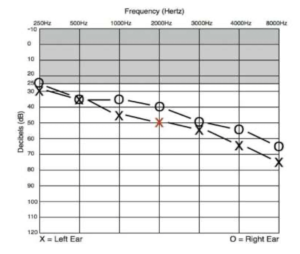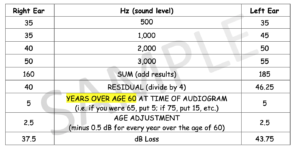OHCOW's Noise-Induced Hearing Loss (NIH) Audiogram Calculation Tool was designed to assess values based on the worker’s audiogram to clarify if their NIHL meets the minimum requirement for establishing a NIHL claim with the Ontario Workplace Safety and Insurance Board (WSIB).
The NIHL Audiogram Calculation Tool allows anyone who has had an audiogram conducted, to input their results into the calculator to determine if those calculations fall within the criteria set out in the WSIB policy for NIHL # 16-01-04.
Other factors involved in the determination of eligibility, include but are not limited to:
• length of time working in a noisy work environment
• decibel levels of noise exposures (continuous exposure to 90 dB (A) of noise for 8 hours per day, for a minimum of 5 years, or the equivalent),
• a pattern of loss consistent with noise-induced sensorineural hearing loss, and
• the calculations taken from the audiogram performed closest to retirement and others, as per this policy.
In Ontario, the WSIB uses the average of the hearing loss at 500, 1000, 2000 and 3000 Hz (hertz)*
to assess entitlement to benefits.
*the four speech frequencies
The readings from these four frequencies are added together and then divided by four (4).
An average hearing loss (in both ears) of 25 dB (decibels), along with a specific pattern of loss, allows eligibility for healthcare and rehabilitation benefits
(the WSIB accepts a 22.5 dB average).
An average hearing loss (in both ears) of 26.25 dB or higher will result in a permanent impairment and the worker will be eligible for a NEL (non-economic loss) award.
As we age, some hearing loss is expected,
and the WSIB will factor this in the following manner:
When considering eligibility, 0.5 dB per year over the age of 60 will be deducted from the average loss.
That is, for every year that you are over 60 years old (at the time of audiogram) the loss will be adjusted by that number.
For example, a worker aged 65 has an average loss of 22.5 dB.
Since the worker is 65, this number is adjusted by multiplying the number of years over the age of (in this case 5) by 0.5 dB, for an age adjustment of 2.5 dB.
Therefore, once adjusted for age (22.5 dB minus 2.5 dB) there is an average loss of 20 dB,
which does not meet the WSIB’s minimum requirement.
The audiogram closest to retirement (if retired) is the only audiogram that will be considered by the WSIB,
therefore calculations using this tool should be done using that audiogram.
If you have any questions about using or applying this tool, please contact us.




